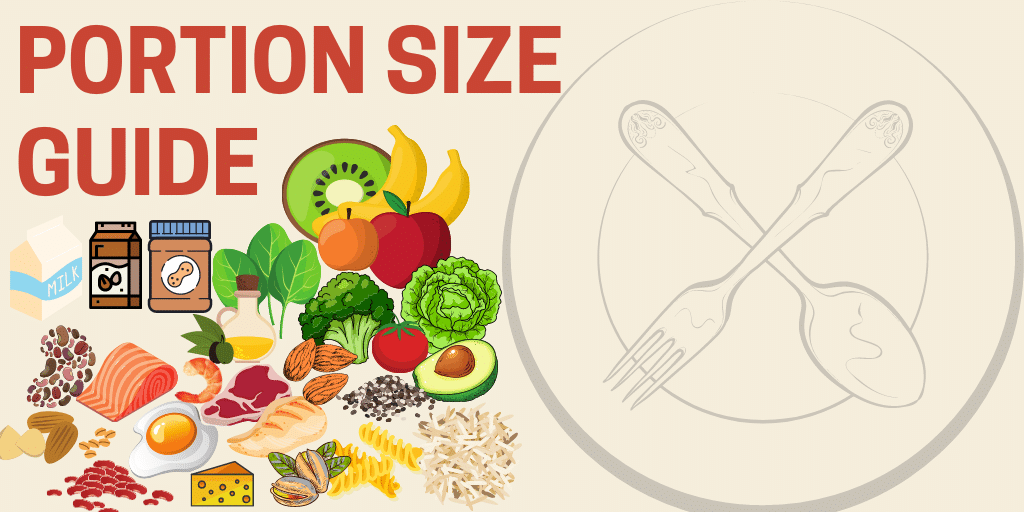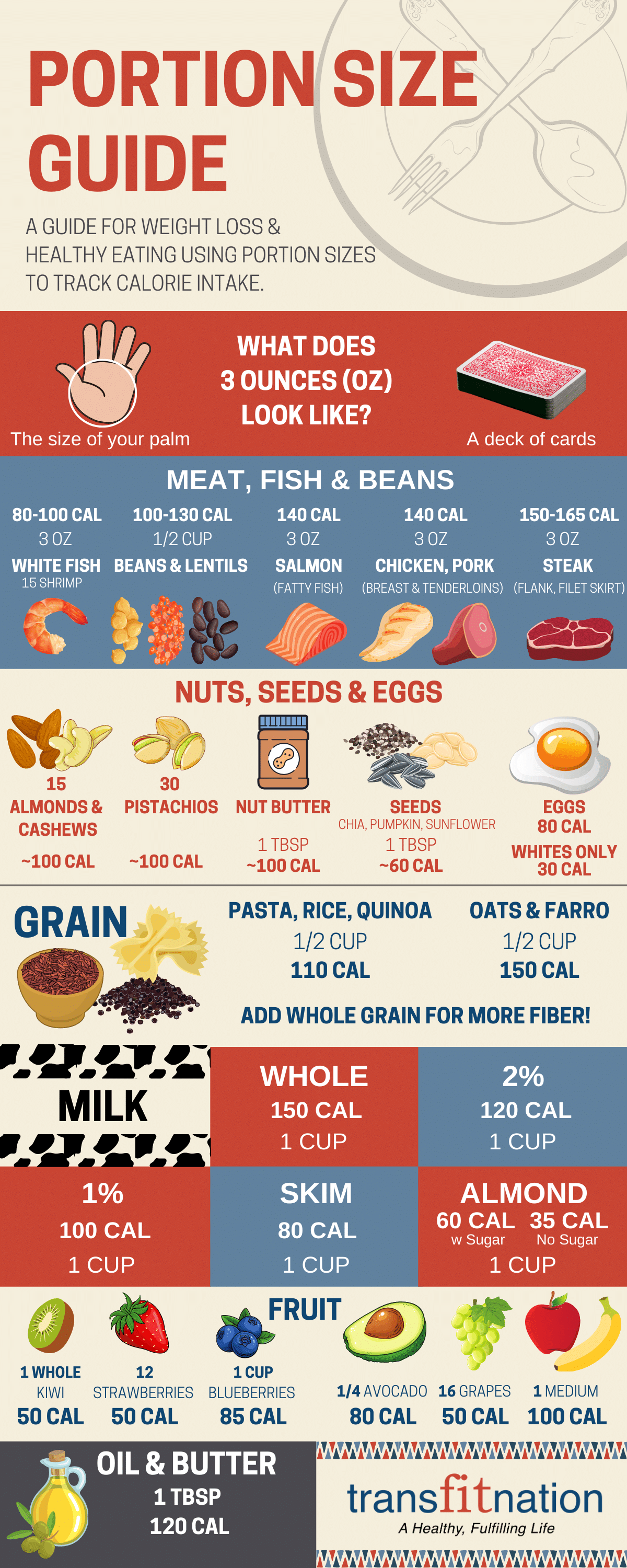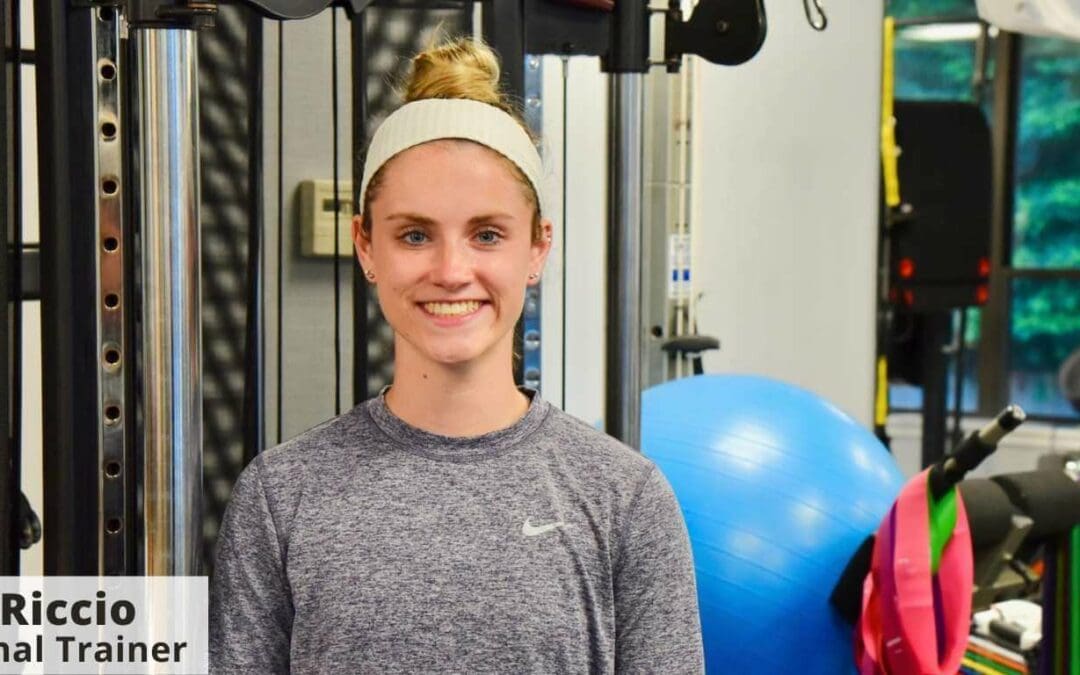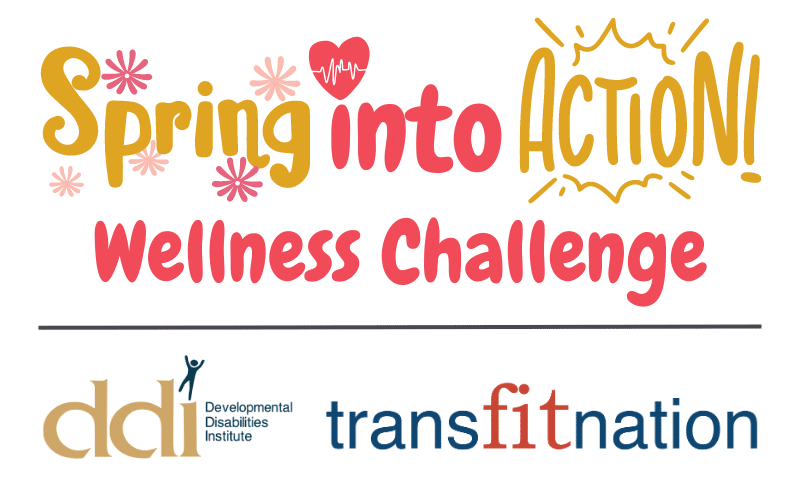Portion Size Guide For Weight Loss & Healthy Eating
A Guide to Help You Measure The Correct Portion Sizes To Reach Your Calorie Intake And Weight Loss Goals. We Break Down The 5 Food Categories to Make It Easy To Measure What You Eat.

Portion Size Guide For Weight Loss & Healthy Eating
In This Article:

What Does 3 Ounces Look Like?
Depending on the size of your hand, your palm should be a good estimate of 3-4 ounces of food. A deck of cards is another example of the size and thickness for 3 ounces of food.
What Is The Right Portion Size For Me?
Your portion size and calorie limits depends on your goals. Calculate the calories needed to reach your goals using our Calorie Intake Plan For Weight Loss, Gains & Maintenance. If you have a weight loss goal, aim for three 300-400 calorie meals (for women) & three 500-600 calorie meals (for men) per day. Use the food categories below to build your meals – try to include 3+ food categories for each meal. As an example for meat, fish and beans, women can have 1 palm (3 ounces ~140 calories) & men can have 2 palms (6 ounces ~ 280 calories) worth of food from this category. The remaining calories can be made up food including whole grains, non-starchy vegetables, fruits, milk, and oil/butter.
Meat, Fish & Beans
Meat, fish, and beans are excellent sources of protein to include in your diet. When comparing the calories in 3 ounces of meat and fish, this is the order in increasing calories: White Fish & Shrimp (80-100 calories) < Salmon (140 calories) < Chicken Breast & Pork Tenderloins (140 calories) < Flank, Filet Mignon & Skirt Steak (150-165 calories).
HEALTHY TIP: To reduce the calories per ounce in meat, choose leaner cuts and remove excess fat and skin before cooking.
Beans are a great vegetarian source of protein. Beans and lentils are around 100-130 calories per 1/2 cup. Examples include black beans, kidney beans, garbanzo beans (chickpeas), soybeans, & lentils.
Nuts, seeds and eggs are additional sources of protein. Due to their heathy fat content, they are more calorie dense. For weight loss, it is important to measure the portion size correctly to prevent overeating.
Examples of 100 calories nut portions include: 15 almonds, 15 cashews and 30 pistachios.
Nut butter, such as peanut or almond butter, is around 100 calories per tablespoon.
1 tablespoon of seeds is around 60 calories. Examples of seeds include chia seeds, pumpkin seeds, sunflower seeds, flaxseed, and hempseed. Seeds can be a great addition to a salad, smoothie or cereal for extra protein and healthy fat!
Eggs are 80 calories per egg with the yolk. To reduce calories try adding egg whites (without the yolk), which are only 30 calories per egg.
Grain
Grain is an important source of fiber and energy in our diets. The fiber in grain can lower our blood sugar levels and helps keep us full for longer periods of time. Examples of whole grain include whole wheat pasta, briwn rice, farro, quinoa, multi-grain bread, and oats.
Pasta, rice and quinoa are 110 calories per 1/2 cup.
Oats & farro are 150 calories per 1/2 cup.
Be sure to measure your grains before eating to stay on track within your daily calorie limits for weight loss.
Milk
Not all milk is equal when it comes to calories. The fat content of the milk plays a role in the calorie density of milk. For example, whole milk is 150 calories, 2% milk is 120 calories, 1% milk is 100 calories, and skim milk is 80 calories per cup. Lower % fat milk contains less calories. This also applies to cheese and yoghurt. Opt for fat-free/skim milk, fat-free cheese and fat-free yoghurt to reduce the calorie content of your food to speed up your weight loss.
Fruit
Fruit contains many nutrients and fiber that are essential for healthy eating. Include fruit in your diet as a snack or a healthy addition to a meal. Examples include 1 kiwi (50 calories), 12 strawberries (50 calories), 1 cup blueberries (85 calories), 1/4 avocado (80 calories), 16 grapes (50 calories), 1 medium apple or banana (100 calories).
The USDA recommends 1-2 cups of fruit per day in a healthy diet. It is important to measure your fruit to stay within the recommended limits. Too much fruit, especially in the form of smoothies, can lead to an increase in body fat storage due to the increased sugar content.
Oil & Butter
It is important to remember that oil and butter add extra calories to our meals. Every tablespoon of oil or butter is worth 120 calories. Remember to measure and look at the nutrition labels for dressings and sauces when calculating the total calories for each meal.
Start Your Transformation Today With A Free Training Session
Related Articles:

Best Weight Loss Center on Long Island 2024 – Transfitnation
Transfitnation proudly announces its nomination as the Best Weight Loss Center on Long Island in the 2024 Best of LI awards. Building on our consecutive nominations in 2021 and 2022, we underscore our dedication to guiding transformative fitness journeys. Our distinctive holistic approach, exceptional team, and nurturing community distinguish us. Embark on your journey to improved health with a complimentary first training session!

Best Personal Trainers on Long Island 2024- Transfitnation
Transfitnation has been nominated for Best Personal Trainer on Long Island in the 2024 Best of LI awards. With past nominations in 2021 and 2022, we showcase our...

Top 10 Exercises To Get a Bigger Butt – Free Workout
Here Are Our Top 10 Exercises To Get A Bigger Butt. Grow Your Glutes With This Free Butt-Building Workout. Squat, Step-up, Split Squat, Deadlift…

Is Spot Reduction A Fact Or A Fantasy?
This article explores the popular idea of spot reduction, where individuals aim to target fat loss in specific areas of the body through exercising that area. We...

Meet Our Personal Trainer – Jill Riccio
Jill is a Certified Exercise Physiologist (ACSM), Certified Sports Nutrition Coach (NASM), and Certified Personal Trainer (NASM). She has knowledge and experience...

Unleashing The Holistic Benefits Of Exercise
Discover the transformative power of exercise for your mind, body, and well-being. Explore the emotional, mental, and social advantages of staying active. Boost your mood, reduce stress, enhance cognitive function, and foster meaningful connections through the holistic benefits of exercise. Embrace a healthier, happier you today!

Transfitnation Launches 8-Week Wellness Challenge Fundraiser to Support DDI
Transfitnation and the Developmental Disabilities Institute (DDI) of Smithtown, have teamed up to launch an 8-week wellness challenge fundraiser from May 8 - June...
